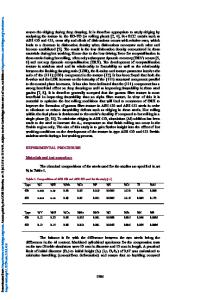Hydrogen Embrittlement Behavior of 430 and 445NF Ferritic Stainless Steels
- PDF / 976,653 Bytes
- 9 Pages / 593.972 x 792 pts Page_size
- 81 Downloads / 348 Views
I.
INTRODUCTION
STAINLESS steels (STSs) are widely used for both low-end applications, such as cooking utensils and furniture, and very sophisticated applications, such as space vehicles and construction materials, because of their desirable combinations of mechanical properties and corrosion resistance.[1] There are three main types of microstructures in STSs, i.e., ferritic, austenitic, and martensitic. These microstructures can be obtained by properly adjusting the steel chemistry. In the STS-related fields, many efforts have recently been devoted to replacing austenitic STSs with ferritic STSs. This is primarily because ferritic STSs have higher yield strength and superior stress corrosion cracking resistance compared to austenitic STSs.[1,2] In addition, the price of Ni, a major alloying element of austenitic STSs, is unstable and high. However, there are some drawbacks of ferritic STSs for replacement of austenitic STSs. One main drawback is their susceptibility to hydrogen embrittlement. Hydrogen absorbed from the environment during processing or service can cause SUN MI KIM and YOUNG SOO CHUN, Ph.D. Candidates, are with the Department of Materials Science and Engineering, Pohang University of Science and Technology, Pohang 790-784, Korea. SUNG YEUN WON, Ph.D. Senior Researcher, and YOUNG HWAN KIM, Ph.D. Senior Researcher and Group Leader, are with the Technical Research Laboratories, POSCO, Pohang 790-785, Korea. CHONG SOO LEE, Ph.D. Professor, is with the Department of Materials Science and Engineering, Pohang University of Science and Technology, and also with the Graduate Institute of Ferrous Technology, Pohang University of Science and Technology. Contact e-mail: [email protected] Manuscript submitted December 22, 2011. Article published online June 13, 2012 METALLURGICAL AND MATERIALS TRANSACTIONS A
sudden failure,[3] especially at regions of high stress concentration.[4–6] In general, hydrogen embrittlement resistance of body-centered cubic (bcc) structured ferrite is inherently inferior to that of face-centered cubic (fcc) structured austenite. Yu and Perng[7] measured that the hydrogen diffusivity in ferrite to be approximately 100,000 times higher than that in austenite at room temperature. Moreover, the solubility of hydrogen affects the hydrogen embrittlement resistance. Singh and Altstetter[5] reported that the austenitic steels have higher hydrogen solubility, by a factor of 103. In ferritic steels, excessive hydrogen is trapped by structural defects, such as grain boundaries, dislocations and microvoids.[8] Trapped hydrogen atoms recombine as hydrogen molecule gas, and fracture is accelerated by various hydrogen embrittlement mechanisms.[9–12] Hydrogen also affects the surface quality of ferritic STSs. Szummer et al.[13] reported that hydrogen charging of ferritic STSs in an aqueous solution resulted in the formation of grain-oriented needle-shaped twins at the surface layer, and many microcracks formed inside such needle-shaped twins and conferred an embrittlement of the hydrogen charged materi
Data Loading...











